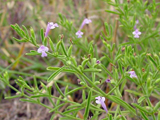Native Plants

Q. Who is Mr. Smarty Plants?
A: There are those who suspect Wildflower Center volunteers are the culpable and capable culprits. Yet, others think staff members play some, albeit small, role. You can torture us with your plant questions, but we will never reveal the Green Guru's secret identity.
Did you know you can access the Native Plant Information Network with your web-enabled smartphone?
Ask Mr. Smarty Plants is a free service provided by the staff and volunteers at the Lady Bird Johnson Wildflower Center.

rate this answer
Friday - November 07, 2014
From: Angleton, TX
Region: Southwest
Topic: Plant Identification, Herbs/Forbs
Title: Identity of blue sage-like plant blooming in September in Lubbock TX
Answered by: Nan Hampton
QUESTION:
This has bothered me for years. It looks like a miniature version of Salvia azure. About a foot talk with multiple stems. Flowering in September. Grows on the hillsides overlooking Buddy Holly Lake in Lubbock. Grows with blackfoot daisy, blue gramma and feathered dalea. Looks biennial to perennial. It's not a skullcap. Thank you.ANSWER:
Since you say it isn't Salvia azurea (Pitcher sage) (USDA Plants Database distribution map shows it occurring in adjacent Lamb County although not in Lubbock County) or Scutellaria resinosa (Resin-dot skullcap) ( USDA Plants Database distribution map shows it occurring in Lubbock County), Mr. Smarty Plants is left with only a few choices that are native and in the Family Lamiaceae (mint family) with flowers that would resemble Salvia azurea. (You will note that I interpreted "blue" rather broadly, including "purple" and "violet" in my search terms as well). They are:
- Hedeoma drummondii (Drummond's false pennyroyal) USDA Plants Database distribution map shows it occurring in Lubbock County. Here are more photos and information from Southwest Colorado Wildflowers.
- Salvia reflexa (Lanceleaf sage) USDA Plants Database distribution map shows it occurring in Lubbock County.
There are three native species of Monarda that occur in Lubbock County, although I don't think they really fit your description. They are
Monarda pectinata (Pony beebalm)
Monarda citriodora (Lemon beebalm)
Monarda clinopodioides (Basil beebalm)
There is one other possibility in the mint family, Lamium amplexicaule (Henbit), an introduced non-native species, that is shown occurring in Lubbock County on the USDA Plants Database distribution map. Here are more photos of henbit from Identify That Plant.
Here are a few possibilities from the Family Scrophulariaceae (Figwort Family) that has flowers that are similar in structure to the mint family flowers.
Nuttallanthus texanus (Texas toad-flax) The USDA Plants Database distribution map shows it occurring in Lubbock County. it normally blooms February through May.
Penstemon buckleyi (Buckley's penstemon) blooms in April-May. The USDA Plants Database distribution map shows it occurring in Lubbock County.
Penstemon fendleri (Fendler's penstemon) blooms April through July. The USDA Plants Database distribution map shows it occurring in Lubbock County.
If none of the above is the plant you saw in bloom in September and you have a photograph or photographs, please visit our Plant Identification page to find links to several plant identification forums that will accept photos of plants for identification. You might also consider contacting someone in the South Plains Lubbock Chapter of the Native Plant Society of Texas to see if they can help you identify the plant.
From the Image Gallery
More Herbs/Forbs Questions
Standing cypress turning brown in San Antonio
June 12, 2011 - Last year I bought and planted a standing cypress. This year several plants came up. The tallest one was about 1 foot tall. After blooming the plant began to turn brown and die. My question: Is t...
view the full question and answer
Lily plants being chewed from Austin
June 20, 2013 - Something is chewing my lily plants to the ground. Any ideas what and do I stop them?
view the full question and answer
Source of Pectis angustifolia from Georgetown TX
December 26, 2012 - You answered an earlier question about Limoncillo (Pectis angustifolia) by saying you had found a source for these seeds in Santa Fe, but the hyperlink was inoperable. I'd like to try to propogate t...
view the full question and answer
Survival of wildflowers after Hurricane Irene in Perkasie PA
September 03, 2011 - Mr. Smarty Plants,
We have (had) a beautiful row of wildflowers and sunflowers along the one side of our house. Now that Hurricane Irene has passed, most of the flowers are matted down from the wind...
view the full question and answer
Are there drug cartels on the bluebonnet trails from Lake City FL
February 08, 2012 - We plan to fly to TX to see bluebonnets but do not know if the weather and forest fires have destroyed them. If not, can you estimate the peak bloom time?
We are 75 and 81 and move around rather s...
view the full question and answer
| Support the Wildflower Center by Donating Online or Becoming a Member today. |

